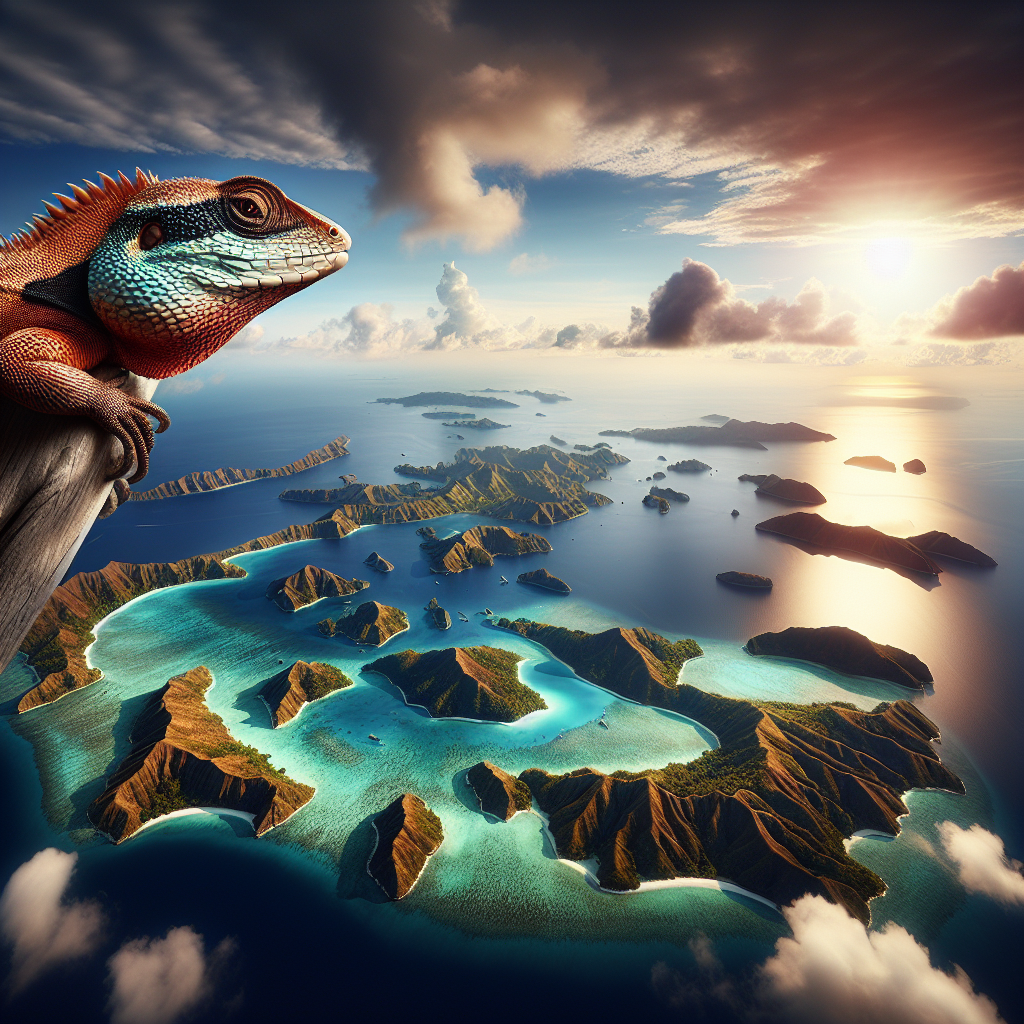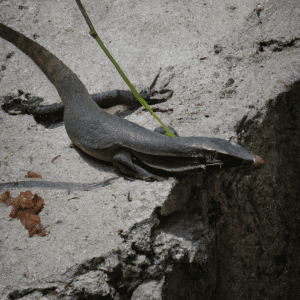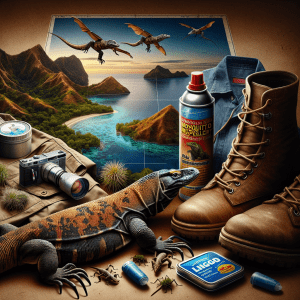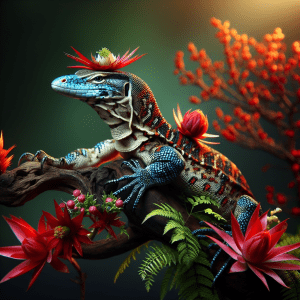Introduction to Lizard Distribution in the Indonesian Archipelago
Indonesia, the land of a thousand islands, harbors a remarkable diversity of lizards in its lush landscapes. Picture this: you’re trekking through the dense rainforest of Borneo, and suddenly, a vibrant green lizard scurries across your path, blending seamlessly with the foliage. That’s the magic of Indonesian lizard distribution – a world where nature’s palette comes alive in the most extraordinary ways.
The Indonesian Archipelago serves as a hotspot for biodiversity, with over 600 species of lizards calling these islands home. From the majestic Komodo dragon to the tiny geckos that cling to walls with effortless grace, each lizard species plays a vital role in the ecosystem.
Did you know that some Indonesian lizards have evolved to glide through the air, using their skin flaps as wings to navigate between trees? It’s a fascinating adaptation that showcases the incredible diversity of life in this region.
As we delve deeper into the world of lizard distribution in Indonesia, we uncover not just the wonders of nature but also the challenges these creatures face in a rapidly changing environment. How can we ensure the conservation of these unique species for future generations to marvel at?
Join me on this journey of discovery as we unravel the mysteries of Indonesian lizard distribution, exploring the hidden gems and untold stories that make this archipelago a haven for reptile enthusiasts and nature lovers alike.
Importance of Understanding Lizard Habitats
Have you ever stopped to think about the importance of understanding lizard habitats? It’s truly fascinating!
Picture this: a lush tropical forest in the Indonesian Archipelago, teeming with diverse lizard species.
This biodiversity is not just a random occurrence—it’s the result of intricate ecological dynamics at play.
Did you know that some lizard species are highly specialized in their habitat preferences?
For instance, the iconic Komodo dragon, a native of Indonesia, thrives in arid savannas and coastal regions.
Understanding these habitat preferences is crucial for the conservation of these magnificent creatures.
By studying the factors influencing lizard distribution, we can better protect their natural habitats.
Imagine a world where every unique lizard species has a fighting chance to survive and thrive.
What practical steps can we take to ensure the preservation of these vital ecosystems?
It’s a thought-provoking question that challenges us to become stewards of our environment.
So, next time you encounter a lizard, take a moment to appreciate its habitat and the delicate balance it represents.
Together, we can make a difference in safeguarding the rich biodiversity of the Indonesian Archipelago.
Biodiversity of Lizards in Indonesia
Are you ready to dive into the fascinating world of lizard diversity in the Indonesian Archipelago? Picture this: lush tropical forests teeming with vibrant colors, echoing with the rustling of leaves as elusive lizards navigate their way through the dense foliage. It’s a sight to behold, and today we’re going to unravel the biodiversity of these magnificent creatures that call Indonesia home.
Indonesia, with its diverse ecosystems and unique geographical features, is a hotspot for lizard species. From the iridescent Tokay geckos to the majestic Komodo dragons, the archipelago is a treasure trove of reptilian wonders. Did you know that Indonesia is home to over 600 species of lizards, each adapted to thrive in specific habitats across the islands?
Exploring the biodiversity of lizards in Indonesia not only showcases the sheer variety of species but also highlights the delicate balance of nature in this region. It’s crucial to understand the intricate relationships between these reptiles and their environments to ensure their survival. Conservation efforts play a vital role in protecting these species from threats such as habitat loss and climate change.
So, as we embark on this journey through the enchanting realm of Indonesian lizard diversity, let’s marvel at the beauty of these creatures and appreciate the interconnectedness of life on our planet. What species do you find most intriguing, and have you ever encountered a lizard in the wild that left you in awe? Join me as we unravel the mysteries of lizard distribution in the Indonesian Archipelago and celebrate the wonders of nature together.
Factors Influencing Lizard Distribution
IV. Factors Influencing Lizard Distribution
Have you ever wondered why some lizard species thrive in certain areas while others struggle to survive? Well, it all comes down to a variety of factors that influence lizard distribution in the Indonesian Archipelago.
Picture this: imagine a dense rainforest teeming with life, where lizards bask in the warm sunlight filtering through the canopy. This rich habitat provides ample food sources and shelter, making it an ideal environment for certain lizard species.
Now, let’s delve into the fascinating world of factors that shape lizard distribution. One key element is climate – different lizard species have evolved to adapt to specific temperature ranges and humidity levels. This means that they are most likely to be found in regions that offer optimal conditions for their survival.
But wait, there’s more! The availability of food sources, competition from other species, and even human activities can also play a significant role in determining where lizards are found. For example, deforestation and habitat destruction can disrupt ecosystems, leading to changes in lizard populations.
So, the next time you spot a lizard darting across your path, take a moment to appreciate the intricate web of factors that have shaped its distribution in the Indonesian Archipelago. Who knew that these seemingly small creatures could hold such a wealth of secrets about their environment?
Endangered Lizard Species in the Archipelago
Imagine standing on the lush jungles of the Indonesian Archipelago, surrounded by a myriad of fascinating lizard species. These creatures, with their intricate patterns and unique behaviors, are a true wonder of nature. As an expert in lizard distribution in this region, let me take you on a journey to uncover the secrets of these incredible reptiles.
Did you know that Indonesia is home to over 350 species of lizards, each with its own story to tell? From the vibrant tokay geckos to the elusive Komodo dragons, the diversity of lizards in this archipelago is simply astounding.
Understanding the factors influencing lizard distribution is like solving a puzzle that spans across different habitats and ecosystems. Climate, food availability, and even human activities play a crucial role in shaping where these fascinating creatures choose to call home.
Conservation efforts are vital to protect the delicate balance of nature and ensure the survival of endangered lizard species. By raising awareness and implementing sustainable practices, we can safeguard the future of these remarkable reptiles for generations to come.
So, the next time you find yourself exploring the Indonesian wilderness, take a moment to appreciate the beauty and diversity of the lizards that inhabit this stunning archipelago. Their presence is a testament to the intricate web of life that surrounds us, waiting to be discovered and cherished.
Conservation Efforts for Indonesian Lizards
Conservation Efforts for Indonesian Lizards
Now, let’s dive into the fascinating world of conservation efforts for Indonesian lizards. Picture this: you’re trekking through the lush rainforests of Indonesia, surrounded by the vibrant sounds of nature. Suddenly, a flash of green catches your eye – a rare lizard species, delicately perched on a tree branch.
Did you know that Indonesia is home to a diverse array of lizard species, each playing a crucial role in the ecosystem? These fascinating creatures face various threats, from habitat loss to illegal wildlife trade. That’s where conservation efforts come into play.
Conservationists and researchers are working tirelessly to protect these unique reptiles and their habitats. By studying their behavior, habitat requirements, and population trends, we can implement targeted conservation strategies to ensure their survival.
One practical tip for supporting lizard conservation is to raise awareness about the importance of these creatures. Educating local communities and tourists about the value of preserving lizard habitats can make a significant impact.
So, here’s a thought-provoking question for you: How can we all contribute to safeguarding the future of Indonesian lizards? By spreading awareness, supporting conservation initiatives, and making conscious choices, we can all play a part in protecting these incredible creatures for generations to come.
Remember, every small action counts when it comes to preserving the rich biodiversity of the Indonesian Archipelago. Let’s join forces to ensure a brighter future for these extraordinary lizards!
Popular Lizard Species for Wildlife Enthusiasts
Are you ready to dive into the fascinating world of Indonesian lizards? Let’s talk about VII., Popular Lizard Species for Wildlife Enthusiasts. Picture this: you’re trekking through the lush rainforests of Indonesia, your eyes scanning the treetops for any movement. Suddenly, a vibrant green lizard catches your eye as it gracefully glides from one branch to another. This magnificent creature is none other than the Wallace’s flying lizard, known for its remarkable ability to glide through the air using its wing-like extensions. Imagine witnessing this incredible sight in person – a moment you’ll never forget!
These popular lizard species in Indonesia are not just captivating to observe but also play crucial roles in the ecosystem. From the strikingly colored chameleons to the elusive Komodo dragons, each species offers a unique glimpse into the diverse world of Indonesian wildlife. Did you know that some lizards in Indonesia have developed camouflage techniques that allow them to blend seamlessly into their surroundings, making them masters of disguise?
For wildlife enthusiasts looking to explore the beauty of Indonesian lizards, embarking on guided tours or nature hikes can provide unforgettable experiences. Local guides often possess a wealth of knowledge about these fascinating creatures, sharing insights about their behaviors and habitats along the way. Whether you’re a seasoned reptile enthusiast or a curious traveler seeking new adventures, encountering these popular lizard species firsthand is sure to leave you in awe of the natural world.
So, are you ready to embark on a thrilling journey through the enchanting realm of Indonesian lizards? Join me as we uncover the secrets of these captivating creatures and celebrate the rich biodiversity of the Indonesian Archipelago!
Research Studies on Indonesian Lizard Distribution
When it comes to researching Indonesian lizard distribution, it’s like diving into a treasure trove of biodiversity. The sheer variety of lizard species in the archipelago is mind-boggling. Did you know that Indonesia is home to over 600 species of lizards? Talk about a lizard lover’s paradise! Exploring the distribution patterns of these fascinating creatures can reveal so much about the environment they inhabit. From the lush rainforests of Sumatra to the volcanic islands of Java, each region has its own unique lizard inhabitants. Imagine trekking through the dense jungles of Borneo, hoping to catch a glimpse of the elusive Komodo dragon. It’s like stepping into a real-life Jurassic Park! Understanding the distribution of Indonesian lizards is not just about identifying species; it’s also crucial for conservation efforts. By mapping out where different lizard species are found, researchers can pinpoint areas that need protection. So, the next time you spot a lizard darting across your path in Indonesia, take a moment to appreciate the intricate web of life that surrounds you. Who knows, you might just stumble upon a new lizard species waiting to be discovered!
Best Practices for Lizard Watching in Indonesia
Have you ever wondered how to enhance your lizard-watching experience in the Indonesian Archipelago? Picture this: you’re on a lush tropical island, surrounded by the mesmerizing sounds of nature. You spot a vibrant green lizard darting across the forest floor. What do you do next? One practical tip for successful lizard watching is to move slowly and quietly, blending into the natural surroundings. By staying patient and observant, you increase your chances of spotting these elusive creatures in their natural habitats. Another key strategy is to research the specific species of lizards found in the region you are exploring. Understanding their behavior, preferred habitats, and active times of day can help you plan your lizard-watching adventures more effectively. Imagine the thrill of encountering a rare lizard species in the wild! This experience not only provides a sense of wonder and connection to nature but also contributes to the conservation of these fascinating creatures. So, next time you embark on a lizard-watching expedition in the Indonesian Archipelago, remember to embrace the beauty of nature and immerse yourself in the captivating world of lizards.
Conclusion: Appreciating the Richness of Lizard Diversity in the Indonesian Archipelago
Have you ever marveled at the diverse world of lizard distribution in the Indonesian Archipelago? It’s a fascinating journey through lush rainforests, vibrant coral reefs, and volcanic terrains. Picture this: a secluded beach where tiny geckos scuttle across the sand like miniature acrobats. These agile creatures are just one example of the rich biodiversity that thrives in Indonesia’s unique ecosystems. As an expert on lizard distribution, I’ve had the privilege of studying these remarkable reptiles up close. One interesting fact that never fails to captivate me is the incredible adaptability of Indonesian lizards to their surroundings. From the iconic Komodo dragon to the colorful agamas, each species has evolved distinct traits to survive in its habitat. Exploring the challenge of conserving these species in the face of environmental threats is a critical issue that requires our attention. Conservation efforts play a vital role in protecting the delicate balance of ecosystems that Indonesian lizards call home. So, next time you venture into the wilderness of the Indonesian Archipelago, keep an eye out for these elusive creatures and marvel at the wonders of lizard distribution in this tropical paradise.




